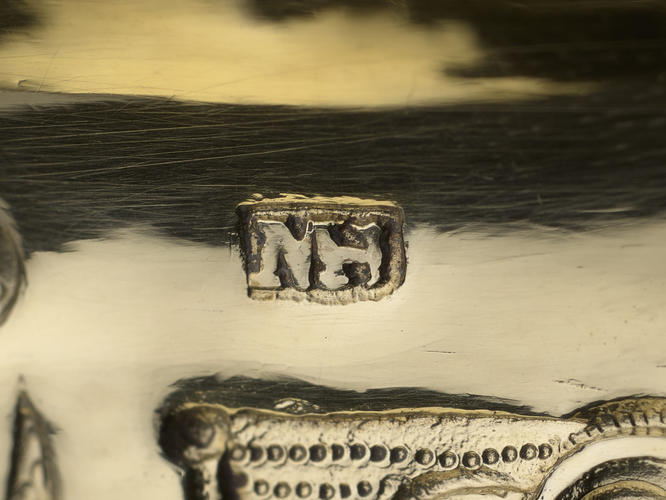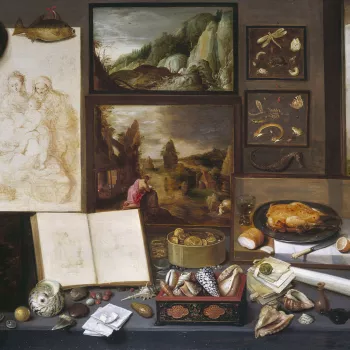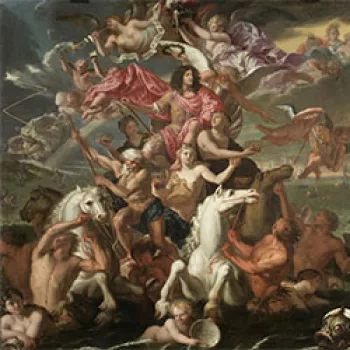Bukelpokal or standing cup and cover c.1610-20
Silver gilt | 58.3 x 16.9 x 16.9 cm (whole object) | RCIN 51466
-
The cup and cover is a particularly large and elaborate example of the type of presentation vessel popular in Nuremburg in the late sixteenth and early seventeenth centuries. It is first recorded in the Royal Collection in about 1830, where it is described in an inventory as 'An ancient Silver Gilt Cup & Cover, presented by His Majesty Charles the First, to one of the Principals of the University of Oxford whilst holding the Parliamt. in that City'. In 1843 the cup was illustrated and described in Henry Shaw's influential publication Dresses and Decorations of the Middle Ages, where an alternative account of its early history was given.Shaw, apparently with the help of John Bridge, records that the cup had formerly belonged to Charles II and that he had presented it to 'a Master of Queen's College', Oxford, for services to his father during the Civil War.
It is unlikely that Charles I would have given away such an object at a time when the Jewel House was heavily depleted and the king was requesting plate from many individuals and institutions, including the Oxford colleges, to help finance the royalist army. If the more likely explanation that it was presented by Charles II in gratitude for services rendered on behalf of his father is true, then the most probable recipient was Thomas Barlow (1608/9–91), Provost of The Queen's College and later Bishop of Lincoln. Barlow became a Fellow of Queen's in 1633 and Librarian of the Bodleian in 1652. He was a learned Calvinist and royalist supporter, who managed to retain his position in College throughout the Interregnum. In 1648, the Parliamentary Visitation of Oxford sought to oust royalist figures from positions of authority in the city. Barlow is attributed with the authorship of an anonymous tract against the Visitation entitled 'Pegasus or the Flying Horse from Oxford, bringing the Proceedings of the Visitors and other Bedlamites'. He was also a subscriber to a secret collection for exiled bishops, founded in 1654. Despite these apparently subversive activities, he survived the Visitation and remained in office; he was elected Provost of Queen's in 1657, and at the Restoration he was one of the commissioners involved in reinstating the members of the University who had been ejected in 1648.
In 1843 the cup was illustrated and described (in its original partly gilt state) in Henry Shaw's influential publication Dresses and Decorations of the Middle Ages, where an alternative account of its early history is given. Shaw, apparently with the help of John Bridge (of Rundell, Bridge & Rundell), records that the cup had formerly belonged to Charles II and that he had presented it to a Master of Queen's College, Oxford, for services to his father during the Civil War. The cup is said to have remained in the same family until the 1820s when it was bought by Rundells and sold by them to George IV.
Given John Bridge's involvement, Henry Shaw's account is probably more reliable than the Carlton House inventory. It is unlikely that Charles I would have given away such an object at a time when the Jewel House was heavily depleted and the King had requested plate from many individuals and institutions, including the Oxford colleges, to help finance the royalist army.
This cup and cover is a particularly large and elaborate example of the type of presentation vessel popular in Nuremberg in the late sixteenth and early seventeenth centuries. With its tall, slender and organic form, embossed bulb decoration and filigree foliage, it is typical of the neo-Gothic style adopted by Nuremberg goldsmiths at this date.
Finial figures representing the Virtues were popular; on this cup Fortitude is symbolised by the column. In 1606, Michel Haussner (master 1601; about whom little else is known) supplied a similar Knorretes Trinkgeschirr ('burred' drinking cup) to the Nuremberg City Council, surmounted by the figure of Patience.
Rim of cup struck with city mark of Nuremberg (entirely worn); cover, rim and foot of cup struck with maker's mark of Michel Haussner.
Text adapted from Royal Treasures, A Golden Jubilee Celebration, London (2002) and Charles II: Art & Power (2017).Provenance
Possibly presented to a Master of The Queen's College, Oxford by Charles II; Rundell, Bridge and Rundell; by whom sold to George IV circa 1820. Sent to Rundells for regilding in 1828.
-
Creator(s)
(goldsmith)Acquirer(s)
-
Medium and techniques
Silver gilt
Measurements
58.3 x 16.9 x 16.9 cm (whole object)
2034.5 g (Weight) (whole object)
Category
Bibliographic reference(s)
EAJ : Jones, E.A., 1911. The Gold and Silver of Windsor Castle, Letchworth p. 6, pl. III












